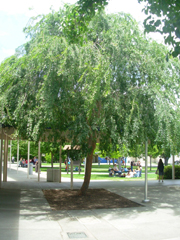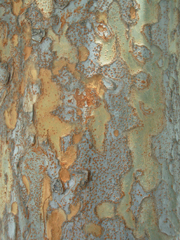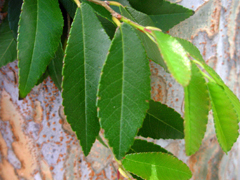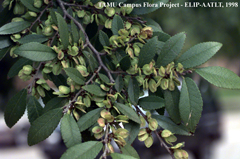Chinese Elm
Ulmus parvifolia (parvifolia = "with small leaves")Family: Ulmaceae
Podcast Script
One of the Chinese Elms at DHS |
The Elm's signature mottled bark |
The leaves in late spring |
Immature fruit taken from www.csdl.tamu.edu |
Classification:
Angiosperm, Dicot, deciduousSize:
Chinese Elms are usually 20- 60 feet tall, but they have been known to reach up to 80 feet. The trunk is 1- 1.5 feet in diameter and the branches are usually about 50 feet across.Identifying Features:
The leaves of the Chinese Elm are especially easy to identify; they are broad, flat, and have teeth of equal size and spacing around the leaf's perimeter. Here are other details about the Chinese Elm's foliage:- Leaf Arrangement: alternate
- Leaf Type/Base: simple/oblique*
- Leaf Shape: obovate*, elliptic (oval), ovate
- Leaf Type & Persistance: semi-evergreen, evergreen
- Leaf Blade* Length: under 2 inches
- Leaf Color (in Fall/ Spring): yellow/ green
- Leaf Texture: rough
- Leaf Margins: serrate
- The Chinese Elm has easily identifiable samara*, but only during the autumn months when its ripened to red from its less conspicuous green. The fruit is winged, oval to circular, and has sparse hair on the outside.
- The bark looks mottled and gray on the outside, but as the bark sheds in thin layers, a rough, reddish color is revealed underneath, creating a very aesthetically pleasing exterior.
- It has slender stems with no terminal buds.
Location/Habitat:
The shaded areas in the map of the United States show where Chinese Elm populations are common.- Although the Chinese Elm is widespread in the United States, its native homeland is Northern Asia, particularly Japan, China, North Korea, and Vietnam.
- It flourishes in moist soils, and humid/temperate conditions. It's much more commonly seen throughout southern United States- predominantly in Pacific and Gulf regions. It can handle heat and cold extremes remarkably well and is used for decoration and ornamental purposes, as well as shading.
Flower/Fruit/Reproduction:
- The flowers of the Chinese Elm are perfect, meaning they have both male and female parts. Although technically they should be able to reproduce asexually, they cannot, and to be pollinated two flowers from different trees must come together.
- Stigma* visible
- Stigma lobes reflexed above anthers*
- Anthers dehiscing*
- Anther dehiscence complete and stigma wilts
- Stigma shriveled, ovule green and enlarged.
- Pollination is intense over a short period of time, about 2-3 days. It occurs during August and September, and the fruit is ripened by October. The fruit is red because the anthers of the flowers are a deep red-orange color.
- The fruit consists of a compressed nutlet surrounded by a membranous wing, and the seed is in the middle of the wing.
- The Chinese Elm is one of the few of the Elm family that waits until early December to shed its leaves. Then by about mid-December, the seeds are ready to be caught by the wind and dispersed. They are papery and dry by this stage, as seen here.
Water/Sun Requirements:
- In order to flourish, the Chinese Elm requires a deciduous habitat and a lot of sun. While it is able to tolerate poor soil, moist, well-drained soil is best. It can handle a wide range of soils including but not limited to; clay, sand, and loam.
- It's very adaptable to various pH's, temperatures, soil conditions, and intense heat.
- Because it is so adaptable, there are no true "rules" for watering or the amount of sun it recieves. While a lot of sun and moist soil are best, it can really handle any condition it's given.
Special Adaptations:
After first being cultivated in 1794, the Chinese Elm was introduced to the United States in the mid-19th century, and since has rapidly increased in popularity. Recently it's become a good replacement for American Elms that have fallen to Dutch Elm disease and the deadly fungi Ophiostoma (Ceratocystis). The Chinese Elm seems unsusceptible to such diseases and has become amazingly resilient. Because of its adaptability to not only pathogens but the environment as well, it can be used in sparse growing areas such as parking lots and along sidewalks for decoration.Other Information:
While it's true that the Chinese Elm can be handy for aesthetics in gardens with poor soil and conditions, it's ability to out-survive other native plants has classified the Elm as invasive. It reproduces quickly and efficiently, turning into a forest of Chinese Elms much faster than would be expected.A much more manageable form of the Elm is used in bonsai gardens. It's distinguishable bark and bright green leaves coupled with it's predictable growing pattern make it very popular to use for beginniners in bonsai growing. Click here for a picture of a bonsai-grown Chinese Elm.
*See the definition here
Reference Sources/Links:
www.inspire.net basic overview of the tree; good up-close pictures of the fruit and leaves.www.na.fs.fed.us/ lists invasive plants- scroll down and click on "chinese elm" to link to a pdf- more in depth and lists hardiness zones
www.ces.ncsu.edu fact sheet and whole tree pictures with a good description of the habitat.
www.hcs.ohio-state.edu more in-depth on the tree's cultivation needs- climate, etc.
www.edis.ifas.ufl.edu advocates for the chinese elm and has good illustrations of the distribution- also details on the foliage, trunk
www.arizonensis.org clear pictures and lists several characteristics unique to the tree.
www.salinasallergyclinic.com broader overview of Elms; lists threats and the Chinese Elm's resilience.
www.nsl.fs.fed.us in-depth description of the tree's reproductive cycle and other characteristics.
www.hort.uconn.edu-fact sheet/overview of the tree with great pictures.
Coombes, Allen J. Trees. Dorling Kindersly, Inc., New York,1992. page 309.
Hora, Bayard (Chief editor). The Oxford Encyclopedia of Trees of the World. Oxford University Press, Oxford, 1981. pgs. 150 & 152
Created by Lucia G. 2007